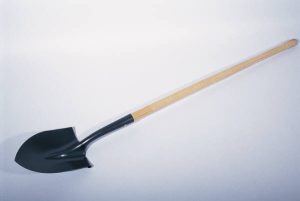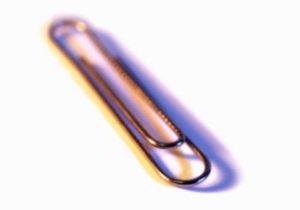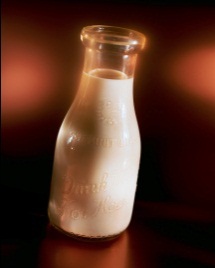Section MU.3 - The Metric System and Converting Between Systems
The Metric System
In the United States, both the U.S. customary measurement system and the metric system are used, especially in medical, scientific, and technical fields. In most other countries, the metric system is the primary system of measurement. If you travel to other countries, you will see that road signs list distances in kilometers and milk is sold in liters. People in many countries use words like “kilometer,” “liter,” and “milligram” to measure the length, volume, and weight of different objects. These measurement units are part of the metric system.
Unlike the U.S. customary system of measurement, the metric system is based on 10s. For example, a liter is 10 times larger than a deciliter, and a centigram is 10 times larger than a milligram. This idea of “10” is not present in the U.S. customary system—there are 12 inches in a foot, and 3 feet in a yard…and 5,280 feet in a mile!
What if you have to find out how many milligrams are in a decigram? Or, what if you want to convert meters to kilometers? Understanding how the metric system works is a good start.
| What is Metric? |
The metric system uses units such as meter, gram, and liter to measure length, mass, and liquid volume (capacity), just as the U.S. customary system uses feet, ounces, and quarts to measure these.
In addition to the difference in the basic units, the metric system is based on 10s, and different measures for length include kilometer, meter, decimeter, centimeter, and millimeter. Notice that the word “meter” is part of all of these units.
The metric system also applies the idea that units within the system get larger or smaller by a power of 10. This means that a meter is 100 times larger than a centimeter, and a kilogram is 1,000 times heavier than a gram. You will explore this idea a bit later. For now, notice how this idea of “getting bigger or smaller by 10” is very different than the relationship between units in the U.S. customary system, where 3 feet equals 1 yard, and 16 ounces equals 1 pound
| Length, Mass, and Volume |
The table below shows the basic units of the metric system. Note that the names of all metric units follow from these three basic units.
| Length | Mass | Volume |
| Basic Units | ||
| meter | gram | liter |
| other units you may see | ||
| kilometer | kilogram | decaliter |
| centimeter | centigram | centiliter |
| millimeter | milligram | milliliter |
In the metric system, the basic unit of length is the meter. A meter is slightly larger than a yardstick, or just over three feet.
The basic metric unit of mass is the gram. A regular-sized paperclip has a mass of about 1 gram. Among scientists, one gram is defined as the mass of water that would fill a 1-centimeter cube. You may notice that the word “mass” is used here instead of “weight.” In the sciences and technical fields, a distinction is made between weight and mass. Weight is a measure of the pull of gravity on an object. For this reason, an object’s weight would be different if it was weighed on Earth or on the moon because of the difference in the gravitational forces. However, the object’s mass would remain the same in both places because mass measures the amount of substance in an object. As long as you are planning on only measuring objects on Earth, you can use mass/weight fairly interchangeably, but it is worth noting that there is a difference!
Finally, the basic metric unit of volume is the liter. A liter is slightly larger than a quart
 |
 |
 |
| Prefixes in the Metric System |
The metric system is a base 10 system. This means that each successive unit is 10 times larger than the previous one.
The names of metric units are formed by adding a prefix to the basic unit of measurement. To tell how large or small a unit is, you look at the prefix. To tell whether the unit is measuring length, mass, or volume, you look at the base.
| Prefixes in the Metric System | ||||||
| kilo- | hecto- | deca- | meter gram liter |
deci- | centi- | milli- |
| 1,000 times larger than base unit | 100 times larger than base unit | 10 times larger than base unit | base units | 10 times smaller than base unit | 100 times smaller than base unit | 1,000 times smaller than base unit |
Using this table as a reference, you can see the following:
- A kilogram is 1,000 times larger than one gram (so 1 kilogram = 1,000 grams).
- A centimeter is 100 times smaller than one meter (so 1 meter = 100 centimeters).
- A decaliter is 10 times larger than one liter (so 1 decaliter = 10 liters).
Here is a similar table that just shows the metric units of measurement for mass, along with their size relative to 1 gram (the base unit). The common abbreviations for these metric units have been included as well.
| Measuring Mass in the Metric System | ||||||
| kilogram (kg) | hectogram (hg) | decagram (dag) | gram (g) | decigram (dg) | centigram (cg) | milligram (mg) |
| 1,000 grams | 100 grams | 10 grams | gram | 0.1 gram | 0.01 gram | 0.001 gram |
Since the prefixes remain constant through the metric system, you could create similar charts for length and volume. The prefixes have the same meanings whether they are attached to the units of length (meter), mass (gram), or volume (liter).
| Converting Within the Metric System |
While knowing the different units used in the metric system is important, the real purpose behind learning the metric system is for you to be able to use these measurement units to calculate the size, mass, or volume of different objects. In practice, it is often necessary to convert one metric measurement to another unit—this happens frequently in the medical, scientific, and technical fields, where the metric system is commonly used.
The table below shows some of the unit equivalents and unit fractions for length in the metric system.
| Units | Conversion Factors | |
| 1 meter = 1,000,000 micrometers | [latex]\frac{1~m}{1,000,000~mm}[/latex] | [latex]\frac{1,000,000~µm}{1~m}[/latex] |
| 1 meter = 1,000 millimeters | [latex]\frac{1~m}{1,000~mm}[/latex] | [latex]\frac{1,000~mm}{1~m}[/latex] |
| 1 meter = 100 centimeters | [latex]\frac{1~m}{100~cm}[/latex] | [latex]\frac{100~cm}{1~m}[/latex] |
| 1 meter = 10 decimeters | [latex]\frac{1~m}{10~dm}[/latex] | [latex]\frac{10~dm}{1~m}[/latex] |
| 1 decameter = 10 meters | [latex]\frac{1~dam}{10~m}[/latex] | [latex]\frac{10~m}{1~dam}[/latex] |
| 1 hectometer = 100 meters | [latex]\frac{1~hm}{100~m}[/latex] | [latex]\frac{100~m}{1~hm}[/latex] |
| 1 kilometer = 1,000 meters | [latex]\frac{1~km}{1,000~m}[/latex] | [latex]\frac{1,000~m}{1~km}[/latex] |
| 1 megameter = 1,000,000 meters | [latex]\frac{1~Mm}{1,000,000~m}[/latex] | [latex]\frac{1,000,000~m}{1~Mm}[/latex] |
Notice that all of the unit fractions contain a factor of 10. Remember that the metric system is based on the notion that each unit is 10 times larger than the one that came before it.
| Example 1 | ||||||||||
| Convert 7,225 centimeters to meters. | ||||||||||
7,225 centimeters converted to meters is 72.25. |
Learning how to solve real-world problems using metric conversions is as important as learning how to do the conversions themselves. Mathematicians, scientists, nurses, and even athletes are often confronted with situations where they are presented with information using metric measurements, and must then make informed decisions based on that data.
To solve these problems effectively, you need to understand the context of a problem, perform conversions, and then check the reasonableness of your answer. Do all three of these steps and you will succeed in whatever measurement system you find yourself using.
| Example 2 | ||||||||||
| In the Summer Olympic Games, athletes compete in races of the following lengths: 100 meters, 200 meters, 400 meters, 800 meters, 1500 meters, 5000 meters and 10,000 meters. If a runner were to run in all these races, how many kilometers would he run? | ||||||||||
The runner would run 18 kilometers. |
| Example 3 | ||||||||||||||||||
| One bottle holds 295 dl while another one holds 28,000 mL. What is the difference in capacity between the two bottles? | ||||||||||||||||||
There is a difference in capacity of 1.5 liters between the two bottles. |
| Example 4 | ||||||||||||||||||||
| A two-liter bottle contains 87 centiliters of oil and 4.1 deciliters of water. How much more liquid is needed to fill the bottle? | ||||||||||||||||||||
The amount of liquid needed to fill the bottle is 0.72 liter. |
| You Try MU.3.A | ||||||||
A. Complete the table below:
B. One boxer weighs in at 85 kg. He is 80 decagrams heavier than his opponent. How much does his opponent weigh? |
| Converting Between Square Units |
| Example 5 |
| a. Convert 15.77 dm2 to dam2
b. Convert 19.223 hm2 to cm2 |
| a. Convert 15.77 dm2 to dam2
1 dam = 100 dm [latex]\frac{15.77~\bcancel{dm^2}}{1}[/latex] • [latex]\frac{1~dam~\cdot~1~dam}{100~\bcancel{dm}~\cdot~100~\bcancel{dm}}[/latex] = 0.001577 dam2 Answer: 0.001577 dam2
b. Convert 19.223 hm2 to cm2 1 hm = 10,000 cm [latex]\frac{19.223~\bcancel{hm^2}}{1}[/latex] • [latex]\frac{10,000~cm~\cdot~10,000~cm}{1~\bcancel{hm}~\cdot~1~\bcancel{hm}}[/latex] = 1,922,300,000 cm2 Answer: 1,922,300,000 cm2 |
| Converting Between Cubic Units |
| Example 6 |
| a. Convert 16.53 mm3 to cm3
b. Convert 33.021 dm3 to mm3 |
| a. Convert 16.53 mm3 to cm3
1 cm = 10 mm [latex]\frac{16.53~\bcancel{mm^3}}{1}[/latex] • [latex]\frac{1~cm~\cdot~1~cm~\cdot~1~cm}{10~\bcancel{mm}~\cdot~10~\bcancel{mm}~\cdot~10~\bcancel{mm}}[/latex] = 0.01653 cm3 Answer: 0.01653 cm3
b. Convert 33.021 dm3 to mm3 1 dm = 10,000 mm [latex]\frac{33.021~\bcancel{dm^3}}{1}[/latex] • [latex]\frac{10,000~mm~\cdot~10,000~mm~\cdot~10,000~mm}{1~\bcancel{dm}~\cdot~1~\bcancel{dm}~\cdot~1~\bcancel{dm}}[/latex] = 33,021,000 mm3 Answer: 33,021,000 mm3 |
| You Try MU.3.B |
| A) Convert 17.217 m2 to dm2
B) Convert 31.292 dm3 to km3 |
Converting Between Systems
We have spent the last several sections learning about the U.S. customary system of measurement, and the metric system. As you might guess, there are many applications where it is useful to be able to convert between measurements of length, mass, and volume (capacity) in the two systems. The table below gives some useful conversions between U.S. and metric measurements:
| Approximate Conversions Between Customary and Metric Systems | |
| Length / Distance | 1 inch (in.) ≈ 2.54 centimeters (cm) |
| 1 foot (ft) ≈ 0.30 meters (m) | |
| 1 yard (yd) ≈ 0.91 meters (m) | |
| 1 mile (mi) ≈ 1.61 kilometers (km) | |
| Weight / Mass | 1 pound (lb) ≈ 0.45 kilograms (kg) |
| 1 ounce ≈ 28.35 grams | |
| 1 pound (lb) ≈ 453.59 grams (g) | |
| 1 ton (T) ≈ 0.91 tonne (t) | |
| Capacity / Volume | 1 fluid ounce (fl oz) ≈ 29.57 milliliters (mL) |
| 1 quart (qt) ≈ 0.95 liters(L) | |
| 1 gallon (gal) ≈ 3.79 liters (L) |
| Example 7 | ||||||||||||
| An Olympic sprinter competes in the 400m dash. How many yards is the race? | ||||||||||||
The race is approximately 439.56 yards. |
| Example 8 | ||||||||||||||
| A patient must be weighed prior to surgery so that the proper dosage of anesthesia can be given. A nurse weighs a patient and finds that he weighs 205 pounds. The anesthesiologist prefers weights in kilograms. What is the patient’s weight in kilograms? Round to the nearest hundredth. | ||||||||||||||
The patient’s weight is approximately 93.18 kilograms. |
| Example 9 | ||||||||||||||||||
| Your work is having its annual potluck, and you are asked to bring 5 gallons of lemonade. When you go to the store, each container of lemonade mix says it will make 6 liters. How many containers do you need to buy? | ||||||||||||||||||
You need to buy 4 containers to bring 5 gallons of lemonade to the annual potluck. |
| Temperature Conversions |
There are three commonly used systems for measuring temperature. One such system is usually used in science and is called the Kelvin scale. We will focus our attention on the other two scales for measuring temperature: Fahrenheit and Celsius. The United States usually uses the Fahrenheit system. In this system, water freezes to ice at 32 and boils at 212. Another commonly used temperature scale is the Celsius scale, where water freezes to ice at 0 and boils at 100. You might notice that in the Fahrenheit scale there is a 180 degree difference (212°F - 32°F) between the temperature where water boils and freezes, while in the Celsius scale there is a 100 degree difference (100 – 0) between the temperature where water boils and freezes. Since neither of these two temperature scales has an absolute starting point (a lowest possible temperature) we cannot meaningfully compare temperatures in these scales using conversion factors.
Instead, we have temperature conversion formulas which allow us to convert temperatures back and forth between Fahrenheit and Celsius.
| To Convert Between | Conversion Formula |
| Celsius to Fahrenheit | [latex]F~=~1.8C~+~32[/latex] |
| Fahrenheit to Celsius | [latex]C~=~\frac{5}{9}(F~-~32)[/latex] |
| Example 10 | ||||||||||
| Your front yard is full of weeds, so you decide to spray it with weed killer. The bottle of weed killer that you purchase says “Do not apply in temperatures below 18 or above 32. What are the corresponding temperatures in degrees Fahrenheit? | ||||||||||
The weed killer should only be applied when the temperature is between 64.4ºF and 89.6ºF. |
| Example 11 | ||||||||||||
| When leaving the hospital with your sick child, you are told to return immediately if her temperature exceeds 101.5. When you get home, you discover your thermometer will only measure temperature in degrees Celsius. At what temperature, in degrees Celsius, would you need to return your child to the hospital? | ||||||||||||
You should return your child to the hospital if her temperature exceeds 38.61°C. |
| You Try MU.3.C |
| What was the temperature in degrees Celsius, if the evening news reports that the high temperature in Phoenix, Arizona today was 115°F? |
| Converting Currency |
| USD ($) Currency Exchange Rates (as of April 4th, 2024) | |
| British pound | 1 USD ≈ 0.79 pound |
| Canadian dollar | 1 USD ≈ 1.35 CAD |
| European euro | 1 USD ≈ 0.92 euro |
| Japanese yen | 1 USD ≈ 151.26 yen |
| Mexican peso | 1 USD ≈ 16.58 pesos |
| Example 12 |
| Olivia is planning to study abroad in Japan. Her grandmother gave her $500.00, USD. How much yen will she have? (The symbol “$”and “USD” are interchangeable) |
| [latex]\frac{500~USD}{1}[/latex] • [latex]\frac{151.26~yen}{1~USD}[/latex] = ___ yen
[latex]\frac{500~\bcancel{USD}}{1}[/latex] • [latex]\frac{151.26~yen}{1~\bcancel{USD}}[/latex] = ___ yen [latex]\frac{500~\cdot~151.26~yen}{1}[/latex] = 75,630 yen Olivia will have 75,630 yen. |
| Example 13 |
| Charlotte had 2500 pesos left over after her vacation to Mexico. How many dollars did she have when she returned to the United States? |
| [latex]\frac{2500~pesos}{1}[/latex] • [latex]\frac{1~USD}{16.58~pesos}[/latex] = ___ USD
[latex]\frac{2500~\bcancel{pesos}}{1}[/latex] • [latex]\frac{1~USD}{16.58~\bcancel{pesos}}[/latex] = ___ USD [latex]\frac{2500~\cdot~1~USD}{16.58}[/latex] = 150.78 USD Charlotte will have $150.78. |
| You Try MU.3.D |
| The monthly rent in London is 711 pounds. How much is this in USD? |
Section MU.3 – Answers to You Try Problems
MU.3.A
A.
| Centimeters | Meters | Kilometers |
| 42,100,000 | 421,000 | 421 |
B. 84.2 kg
MU.3.B
a) 1721.7 dm2
b) 0.000000000031292 km3
MU.3.C
46.1
MU.3.D
$900.00

